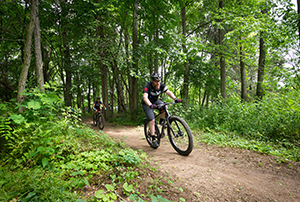
Month: January 2020


Shovel Snow Safely: 12 Tips
When snow accumulates, keep heart health in mind and pace yourself when shoveling sidewalks and driveways.
Here are some facts:
- Shoveling snow can be hard work. Clearing snow for 15 minutes qualifies as moderate, physical activity. However, for many sedentary, out-of-shape Americans, shoveling heavy, wet snow for 10 minutes is the equivalent of running on a treadmill to the point of exhaustion. Studies show major snow storms are often associated with increased emergency room visits for everything from muscle aches to heart attacks, and the common denominator is snow shoveling.
- The cold temperatures don’t help. Cold air raises blood pressure in people who don’t normally have a blood pressure problem and poses an even greater risk to people with high blood pressure, according to University of Florida researchers.
- Wearing a hat can help. In bitterly cold temperatures, wearing a warm hat helps keep your body warm because a lot of heat can be lost via the scalp if uncovered in very cold conditions.
Blue Cross physicians offer the following tips to help prevent shoveling snow from becoming a pain in the neck, or result in a more serious condition. If you have any of the following conditions (or a family history), talk to your physician before shoveling snow:
- A history of heart problems, heart disease or previous heart attack
- Previous experience with back problems or asthma
- High blood pressure
- High cholesterol level
- Past history of smoking or are a current smoker
- Lack of daily, dedicated physical activity
For healthy, active individuals, Blue Cross suggests the following snow shoveling tips:
- Use the right shovel. Shovels with S-shaped handles and non-stick blade surfaces usually require less effort and minimize chances of back pain that could result from improperly bending or twisting. Remember – pushing or pulling snow out of the way requires less exertion.
- Avoid stimulants (for example, caffeine and nicotine) that can raise your heart rate and restrict blood vessels.
- Avoid shoveling immediately after eating a large meal.
- Before shoveling, warm-up by stretching muscles, especially in the morning. Muscles are less susceptible to injury during physical activity after a warm-up.
- Avoid dehydration by drinking fluids before and during shoveling, but not coffee (see above). Breathing cold air dehydrates the body.
- Dress in layers so you can remove or add outerwear as needed. Wear a scarf or mask and/or goggles, especially in windy or blizzard conditions. Use your scarf around your neck and face to create a “well effect” in order to avoid directly inhaling cold air, which may constrict arteries, decreasing your heart’s oxygen supply.
- Go slow and ease into the work to avoid a sudden load on your heart. An average shovelful of heavy, wet snow weighs 16 to 20 pounds. That means for every 10 minutes of typical shoveling, you’ll be clearing more than 2,000 pounds of the white stuff. To remove snow, bend from the knees, keep your back straight, lift with your legs and carry — don’t throw — it to the side. Try and avoid heavy lifting by pushing or pulling the snow out of the way when possible. Newly fallen snow is usually lighter, so don’t wait to remove it. Remove heavy snow in two stages: First, skim off the top layer, and then remove the bottom. If snow is too heavy to lift, push or pull it out of the way. Take frequent breaks.
- Immediately stop if you feel any sort of pain, discomfort, pressure or squeezing in your chest, stomach upset or discomfort in one or both arms or jaw. No one knows your body as well as you. People with a history of any sort of cardiac condition should check with their physician before shoveling snow or avoid doing it.
- If you have a lot to clear, consider hiring a snow removal service.
- Using a snow blower has its own set of rules. First, follow manufacturer safety precautions completely. NEVER attempt to clear a clogged or stuck blade or auger unless power is shut off. Avoid wearing anything that easily can get caught in the impeller, such as a long scarf or dangling clothing, laces or ties. Before starting, be sure children and others stand clear to avoid being injured by hidden objects thrown into the air. Just the act of using a snow blower will elevate heart rates, so talk to your doctor if you have a history of heart problems.
- Don’t forget that slip and fall injuries are more common in snow so be careful when walking outside.
- Let someone know when you will be shoveling so that they can help in the event of any unexpected problems that may occur outdoors.
Like this post? Check these out:
This article was originally published on www.ahealthiermichigan.org, a website sponsored by Blue Cross Blue Shield of Michigan. Blue Cross and MADA are your trusted partners in building a healthier business and workforce.
Photo credit: WDNet
Starting March 1, residents will pay $12 for Recreation Passport
Passport gives year-round access to state parks and other outdoor recreation opportunities, and an easy way to help protect natural resources for the next generation
If you told Michigan residents that for just $1 a month they could enjoy vehicle access to more than 100 state parks and recreation areas, 140 state forest campgrounds, hundreds of miles of state trails, historic sites, family-friendly events, hundreds of boating access sites and other outdoor spaces, most likely would jump at the chance. Starting March 1, they can.
|
The change is due to a statutory provision to adjust the Recreation Passport fee based upon the Consumer Price Index as determined by the federal Bureau of Labor Statistics. That statutory requirement was put into law when the Recreation Passport funding model was created in 2010 to ensure the funding source keeps pace with inflation.DNR Parks and Recreation Chief Ron Olson said it isn’t widely known that Michigan state parks are largely self-supporting. The steady growth in Recreation Passport revenue has been a key part in helping the department tackle some high-priority areas. |
|
Approximately 93.5 percent of state parks funding is generated by user fees and royalty revenues:
The remaining funding – approximately 6.5 percent – is provided from miscellaneous sources (including general tax dollars). |
RECREATION PASSPORT BACK STORY
|
The Citizens Advisory Committee for Michigan State Parks, created in 2005, was charged with finding a long-term funding solution that would 1) address the nearly $300 million backlog of infrastructure needs, and 2) ensure that Michiganders could affordably continue using the parks. The committee ultimately recommended the creation of the model linking motor vehicle registrations to the Recreation Passport.“Those early conversations and research done by the citizens committee and many DNR employees laid the foundation for today’s Recreation Passport,” Olson said. “These were important steps in the right direction.” The next few years made it clear that the existing funding model could not keep the state parks and recreation system afloat. Work on the new Recreation Passport funding model began in earnest, supported by bipartisan cooperation in the state House and the Senate, and the Recreation Passport bill was signed into law in April 2010 and took effect six months later. |
RECREATION PASSPORT RATIONALE, STRUCTURE
 The Recreation Passport model is based both on reducing the customer’s cost and tying the purchase of a park pass to the Secretary of State’s vehicle registration process. The change relied on the notion that more people would buy the new Recreation Passport than would purchase the existing motor vehicle permit because: The Recreation Passport model is based both on reducing the customer’s cost and tying the purchase of a park pass to the Secretary of State’s vehicle registration process. The change relied on the notion that more people would buy the new Recreation Passport than would purchase the existing motor vehicle permit because:
During the Recreation Passport’s first year, an additional $7 million was generated. All revenue generated by Recreation Passport sales goes into a restricted fund that supports state park infrastructure and operations, a local grant program for community recreation agencies, state forest campgrounds and nonmotorized pathways and trails, cultural and historic resource restoration, and marketing and promotion. |
NONRESIDENT RECREATION PASSPORT FEE
The Consumer Price Index change also signaled a one-dollar increase – from $33 to $34 – for nonresident Recreation Passport purchases, effective Jan. 1, 2020. All other passport fees will stay the same.
The start dates for the increase to both residents and nonresidents are staggered due to the time it takes to integrate changes tied to vehicle registration.
SEE WHERE IT CAN TAKE YOU
 View this 30-second video highlighting just a few of the many outdoor adventures you can enjoy with a Recreation Passport. View this 30-second video highlighting just a few of the many outdoor adventures you can enjoy with a Recreation Passport.Learn more about how the Recreation Passport supports, protects and provides easy, affordable access to the great outdoors at Michigan.gov/RecreationPassport. |
https://www.michigan.gov/dnr/0,4570,7-350-79137_79770_79780-517132–,00.html
IRS issues standard mileage rates for 2020
The Internal Revenue Service has issued the 2020 optional standard mileage rates used to calculate the deductible costs of operating an automobile for business, charitable, medical or moving purposes.
Beginning on Jan. 1, 2020, the standard mileage rates for the use of a car (also vans, pickups or panel trucks) will be:
- 57.5 cents per mile driven for business use, down one half of a cent from the rate for 2019,
- 17 cents per mile driven for medical or moving purposes, down three cents from the rate for 2019, and
- 14 cents per mile driven in service of charitable organizations.
The business mileage rate decreased one half of a cent for business travel driven and three cents for medical and certain moving expense from the rates for 2019. The charitable rate is set by statute and remains unchanged.
It is important to note that under the Tax Cuts and Jobs Act, taxpayers cannot claim a miscellaneous itemized deduction for unreimbursed employee travel expenses. Taxpayers also cannot claim a deduction for moving expenses, except members of the Armed Forces on active duty moving under orders to a permanent change of station. For more details, see Rev. Proc. 2019-46.
The standard mileage rate for business use is based on an annual study of the fixed and variable costs of operating an automobile. The rate for medical and moving purposes is based on the variable costs.
Taxpayers always have the option of calculating the actual costs of using their vehicle rather than using the standard mileage rates.
A taxpayer may not use the business standard mileage rate for a vehicle after using any depreciation method under the Modified Accelerated Cost Recovery System (MACRS) or after claiming a Section 179 deduction for that vehicle. In addition, the business standard mileage rate cannot be used for more than five vehicles used simultaneously. These and other limitations are described in section 4.05 of Rev. Proc. 2019-46.
Notice 2020-05, posted today on IRS.gov, contains the standard mileage rates, the amount a taxpayer must use in calculating reductions to basis for depreciation taken under the business standard mileage rate, and the maximum standard automobile cost that a taxpayer may use in computing the allowance under a fixed and variable rate plan. In addition, for employer-provided vehicles, the Notice provides the maximum fair market value of automobiles first made available to employees for personal use in calendar year 2020 for which employers may use the fleet-average valuation rule in § 1.61-21(d)(5)(v) or the vehicle cents-per-mile valuation rule in § 1.61-21(e).
https://www.irs.gov/newsroom/irs-issues-standard-mileage-rates-for-2020
EGLE offers grants of up to $70,000 for EV fast chargers
The Michigan Department of Environment, Great Lakes, and Energy (EGLE) recently announced that public or private organizations can apply for up to $70,000 each toward the cost of installing direct current fast chargers for electric vehicles under a request for proposals (RFP).
The rebates are aimed at encouraging the buildout of an EV fast charging network for automobiles and light-duty vehicles across the state. The goal of building out the state’s EV charging network is to improve air quality, reduce vehicle emissions, and protect public health and the environment.
The grants are part of the more than $9.7 million allocated to Michigan from the Volkswagen diesel emissions settlement. Successful applicants can use their allocation for charger site preparation, equipment installation, networking fees, and signage. Applicants must be enrolled in a utility-sponsored charging program in the area where a charger is proposed to be installed. The EGLE grants are expected to cover up to a third of the total project costs with the host site and utility each also contributing a third.
“We’re seeing fundamental changes in the transportation sector in Michigan with the move toward electric vehicles,” said Jack Schinderle, director of EGLE’s Materials Management Division. “Our grants – along with funding from our utility partners and host sites – will continue to expand the support network needed for a seamless EV user experience across our state.”
Any public or private organization in Michigan, or those outside of Michigan that have demonstrated significant experience in installing and maintaining EV charging stations and have a significant presence in Michigan, are eligible to apply for grants. The RFP lists 75 eligible locations for chargers and proposed projects must be within five miles of those locations.
Grant applications must be submitted online. Funding will be awarded on a first-come, first-serve basis until all the money has been allocated. For further information, contact the Environmental Assistance Center at 800-662-9278 or check the Michigan Fuel Transformation website for more information.

MADA Thanks Our Outgoing President & Welcomes A New Slate of Officers
With 2019 now officially behind us, MADA would like to thank Mr. Jeff Williams for serving as our association president. He put in a lot of time and effort behind the scenes to support the interests of our members in Michigan. We appreciate his commitment to dealers throughout Michigan and look forward to working with him in his final year on the executive committee, as he transitions into his role as MADA’s immediate past president.
We welcome in the new 2020 MADA officers, who were announced and approved during the MADA Annual Meeting in December. We thank them for agreeing to serve this year.
- President Steven Brown
- First Vice President William Perkins
- Second Vice President Cliff Cicotte
- Immediate Past President Jeff Williams


 The Michigan Department of Natural Resources announced that the regular Recreation Passport vehicle entry fee for residents will increase from $11 to $12 – the first Recreation Passport price increase since January 2013. All other resident Passport fees stay the same, including those for motorcycles, mopeds and commercial vehicles.
The Michigan Department of Natural Resources announced that the regular Recreation Passport vehicle entry fee for residents will increase from $11 to $12 – the first Recreation Passport price increase since January 2013. All other resident Passport fees stay the same, including those for motorcycles, mopeds and commercial vehicles. “Although we were not anticipating a $1 increase this year, the additional revenue will help fill in funding gaps,” Olson said. “We are continually working on challenges including rising wages, the ever-increasing cost of goods and services and $278 million worth of significant infrastructure repairs and projects.”
“Although we were not anticipating a $1 increase this year, the additional revenue will help fill in funding gaps,” Olson said. “We are continually working on challenges including rising wages, the ever-increasing cost of goods and services and $278 million worth of significant infrastructure repairs and projects.” In 2004, state parks were removed from the state’s general fund because it was believed that camping fees could sustain the then 99-park system. As a result, revenue generated by motor vehicle stickers and camping fees became even more critical.
In 2004, state parks were removed from the state’s general fund because it was believed that camping fees could sustain the then 99-park system. As a result, revenue generated by motor vehicle stickers and camping fees became even more critical.